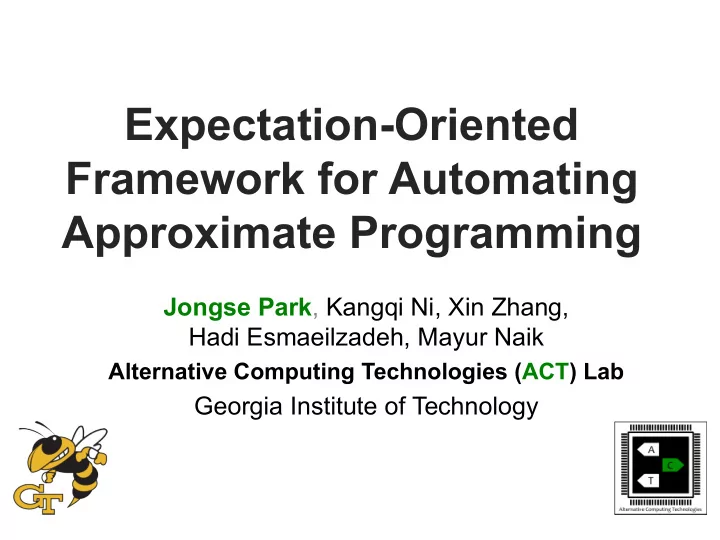

Expectation-Oriented Framework for Automating Approximate Programming Jongse Park , Kangqi Ni, Xin Zhang, Hadi Esmaeilzadeh, Mayur Naik Alternative Computing Technologies (ACT) Lab Georgia Institute of Technology
Approximate Programming Programmer’s manual/explicit specification [EnerJ PLDI’11, Rely OOPSLA’13] AUTOMATE approximate programming
Approximate Programming Programmer’s manual/explicit specification [EnerJ PLDI’11, Rely OOPSLA’13] AUTOMATE approximate programming Where? How much?
ExpAX Overview Source Code Error and Source Code Approximation Approximate Expectation Energy Safety Operations Checker Analyzer Expectation Analysis Selector programming Analysis Optimization Approximate Program
Programming Model Programmer’s Annotations with Expectation 1. accept rate(v) < c e.g. accept rate(v) < 0.2 2. accept magnitude(v) < c using f e.g. accept magnitude(v) < 0.1 3. accept magnitude(v) > c using f with rate < c’ e.g. accept magnitude(v) > 0.9 with rate < 0.3
Approximation Safety Analysis Find possible safe-to-approximate variables Unsafe-to-approximate variables 1. Variables violating memory safety 2. Variables violating functional correctness
Approximation Safety Analysis Backslicing Analysis For each variable v in program, find all variables contributing to the variable v unsafe -to-approximate variables should be precise Everything else should be precise variables
Example Float ¡sobel ¡(float[3][3] ¡ p ) ¡{ ¡ ¡ ¡ ¡ ¡float ¡ x, ¡y, ¡gradient; ¡ ¡ ¡ ¡ ¡ x ¡ = ¡ (p[0][0] ¡+ ¡2 ¡* ¡p[0][1] ¡+ ¡p[0][2]); ¡ ¡ ¡ ¡ ¡ x ¡ += ¡( p[2][0] ¡+ ¡2 ¡* ¡p[0][1] ¡+ ¡p[2][2]); ¡ ¡ ¡ ¡ ¡ y ¡ = ¡( p[0][2] ¡+ ¡2 ¡* ¡p[1][2] ¡+ ¡p[2][2]); ¡ ¡ ¡ ¡ ¡ y ¡ += ¡( p[0][0] ¡+ ¡2 ¡* ¡p[1][1] ¡+ ¡p[2][0]); ¡ ¡ ¡ ¡ ¡ gradient ¡= ¡sqrt (x ¡ * ¡ x ¡+ ¡ y ¡ * ¡ y); ¡ ¡ ¡ ¡ ¡... ¡ ¡ ¡ ¡ ¡return ¡ gradient ; ¡ edgeDetection ¡ } ¡ void ¡edgeDetection(Image ¡&src, ¡Image ¡&dst) ¡{ ¡ ¡ ¡ ¡ ¡ ¡ ¡grayscale(src); ¡ ¡ ¡ ¡ ¡ ¡for ¡( int ¡y ¡= ¡…) ¡ ¡ for ¡( int ¡x ¡= ¡…) ¡ ¡ ¡ ¡ ¡ ¡ ¡ ¡ ¡ ¡ ¡ ¡ ¡dst[x][y] ¡= ¡ sobel (window(src, ¡x, ¡y)); ¡ ¡ ¡ ¡ ¡ ¡ accept ¡rate(dst) ¡< ¡0.1; ¡ } ¡
Optimization Find a subset of safe-to-approximate operations • Minimize error • Maximize energy saving Objective function − 1 ( ) f ( subset ) = α × error + β × energy Genetic algorithm phenotype : a bitvector representing a subset (approximate(‘0’) or precise(‘1’))
Statistical Guarantee error Find a subset of best phenotype! best phenotype error expectation generation
Statistical Guarantee error Find a subset of best phenotype! best phenotype error expectation generation For each eval in genetic algorithm: calculate a score for each operation " % α × error + β × energy ∑ f ( operation ) = ' / n ( Eval ) $ n ( approx ) # & eval ∈ Eval
Space Exploration with Transformed Best Phenotype 1(0.1) evaluate 1(0.1) . 0 0 sort w.r.t . test inputs 0 . 0 scores 0 . 1(0.1) 0 . 1(0.5) . 1(0.8) 1(0.5) 0 . 0 . 0 0 1(0.2) . 1(0.8) 0 0 . 0 1(0.3) 1(0.7) 1(0.2) 0 1(0.5) 1(0.5) 0 1(0.8) . 1(0.3) 1(0.1) 1(0.3) . 0 0 0 . 1(0.2) 0 . 1(0.2) 0 . 1(0.1) . 0 1(0.7) . 0 . . . 1(0.3) . 0 . 1(0.2) 0 . 0 0 Best 0 phenotype . . . . . .
Evaluation Benchmarks: scimark2 – FFT, LU, SOR, MonteCarlo, SMM Imagefill, raytracer, jmeint, zxing Analysis tool: Jchord – Open source programming analysis platform for Java Simulator: Open-source simulator provided by EnerJ
Analysis Result BenchName Enerj: # of Annotations ExpAX: # of Expectations FFT 27 1 LU 20 1 SOR 9 1 MonteCarlo 3 1 SMM 8 1 imagefill 28 7 RayTracer 27 2 jmeint 113 1 zxing 172 15
Genetic Algorithm Results LU
Conclusion Expax: an expectation-oriented framework for automating approximate programming 1. Programming model with a new program specification 2. Approximation safety analysis 3. Optimization framework with heuristics for statistical guarantee
Recommend
More recommend